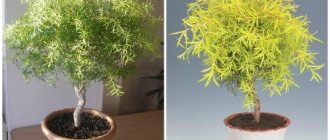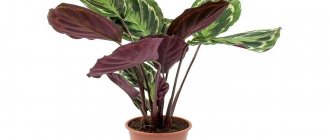Calathea care at home, which is considered not an easy task, becomes a bright decoration of any room due to its amazingly beautiful foliage. How to grow a native of the tropics is described in our article. Despite the fact that the plant is quite capricious, nevertheless, it is one of the favorites of avid gardeners.
It has long been believed that calathea promotes peace and happiness in the family. Some people even wear a pendant with the image of this flower so that they always have good luck and harmony in their family life. As astrologers say, Calathea received this quality of extinguishing aggression as a result of its close connection with Mars and the Sun.
Types and varieties
The leaves of the flowers come in a wide range of colors. This can be seen in the photo. There are combinations of different tones of such primary colors as green, yellow and white. There are also species in which the leaves are pure green with pinkish veins or even patterns. Several species of this plant are most often grown as indoor plants.
Varshevich
This species belongs to flowering plants. Varshevich's peduncle shape is very original. It consists of a white or pink bract, which twists into a spiral, and small flowers grow inside in the axils. The front side of the leaves has a dark green color and a velvety coating. The reverse side of the leaves is smooth, with a beautiful combination of purple and burgundy colors.
Lansifolia
With good care, the plant produces white flowers. Short flower stalks are visible at the very base of the bush. Lansifolia 's leaves is elongated, the color on the underside is red-violet, and on the front it is light green with a darker geometric pattern. The indoor plant can be grown up to 80 cm in height.
Rufibarba
This species also blooms with yellow flowers at home. They are found at the base of the Rufibarba . Wavy leaves of a single green color stretch upward on long petioles.
Medallion
This species can grow up to 40 cm in height. The plant is very beautiful with oval-shaped leaves. They have light patterns and small areas of silver color. In the evening, the leaves of the Medallion turn so that their purple underside becomes visible.
Sanderiana
When grown indoors on a windowsill, it can reach only 50 cm in height.
Sanderiana has wide leaves, decorated with white and pink veins on the front side. The reverse side is burgundy.
Crocata
This flower belongs to the species of flowering Calathea Saffron. A special feature of Crocat is the bright bracts, colored in the color of saffron saffron. They are located on dense and long peduncles, which are located above the leaves. They bloom with small flowers for up to 4 months, even in winter. The leaves are unpatterned, green above and brown below.
Mix
This variety has unusual leaves that are rich in a variety of colors and patterns.
The mix may even have a geometric pattern, which is not often found in nature. Sometimes on its thin leaves you can see veins in the light.
Botanical description of the plant
Calathea sanderiana is a perennial plant. It has a long creeping root that grows horizontally rather than downward. Rosettes of ovoid-shaped leaves extend from the rhizome, distinguished by their large size, their length reaches 20 cm and width - 13 cm. The height of the bush reaches one and a half meters in natural conditions, the indoor plant grows 60–70 cm. The diameter of the flower is the same. Every year, 5-6 leaves are added to the bush. The trunk of the plant is short, the internodes are located close to each other, giving the impression that the rosette is growing from the ground.
How to care for calathea at home
Under natural conditions, Calathea crocata can reach a height of several meters. It lives in forests with a humid tropical climate, where the air temperature is always very high.
It takes root in places where direct sunlight does not fall on its foliage. When growing a calathea flower in a room, it is necessary to bring it as close as possible to natural conditions. It is important to adhere to all the rules for growing and caring for the plant. Otherwise, the calathea will lose its appearance, stop developing and die.
What soil is suitable for Calathea?
The issue of soil for this flower must be approached with special care. It must meet the following requirements:
- Maximum amount of nutrients.
- Porosity and good air circulation.
- Uniform supply of moisture.
- Slightly acidic environment.
It is better to purchase a ready-made substrate in the store, which is made specifically for the Marantaceae family, including the Calathea flower . You can also use soil for Saintpaulias and Azaleas. In this case, it is recommended to introduce perlite into the soil to improve its quality.
To prepare the mixture yourself, combine:
- 2 parts peat
- 2 parts leaf soil,
- 2 parts humus;
- 1 part coarse sand.
Experience has shown that it is good to add 40 g of crushed charcoal or sphagnum to 1 kg of such soil.
You can prepare the soil according to another scheme:
- 2-3 parts of leaf soil;
- 1 part peat;
- 1 part pine mixture;
- 1 part humus;
- 1 part sand.
Optimal conditions of detention
It is important for flower growers to know the natural conditions for growing calathea in order to create them in the house. Then the plant will delight the household with its beautiful appearance and even flowers.
It is necessary to allocate a place for the flower where diffused sunlight will fall on it. The best place for calathea is near a western or eastern window. She needs up to 16 hours of daylight. In winter, additional fluorescent lighting is installed.
In the summer, when the plant is in the active growth stage, the air temperature should be 23-24 degrees, and at night - about 17 degrees. During the plant's sleep period, the temperature should be reduced:
- during the day - 20 degrees,
- at night – the same 16-18 degrees.
Important! With a sharp change in temperature or in drafts, the calathea can get sick.
Watering
The plant must be watered when the soil in the flowerpot dries 1.5-3 cm deep. In the hot season, it is watered 3 times a week, and in winter it can be watered once. The main thing is not to let the soil dry completely, as it will be difficult to return the flower to its previous appearance.
Advice! It is necessary to water the plant with soft water, and its temperature should be 2 degrees above room temperature.
To retain moisture longer, it is recommended to cover the substrate with special moss.
The plant, originally from the tropics, requires air humidity of 60% or higher, ideally 90%. At home, the air is humidified in different ways.
- Spray water around the plant, trying not to get it on the leaves, as this will cause spots to appear on them. Species with velvet leaves are not sprayed.
- To achieve the required humidity for the flower, the flowerpot is placed in a tray filled with wet expanded clay. Moreover, the water level should not be higher than the bottom of the pot.
- Place a container of water near the flower.
- The smooth leaves of some calathea varieties can sometimes be wiped with a damp cloth.
Feeding and fertilizer
You need to know that calathea does not like calcium. For this, you need to choose fertilizers that do not contain this element. It is better to buy a liquid mixture with a low nitrogen content. Typically, such fertilizing is intended for decorative deciduous plants.
Flowering calathea requires phosphorus.
- In summer, the plant requires feeding 2 times a month.
- In winter, fertilizer can be introduced, but with a reduced concentration of almost 2 times and once every 5-6 weeks.
Replanting and pruning
To stimulate the growth of a young plant, the soil in the pot is changed every year. After 4 years, the flower is transplanted every 2 years.
Transplant rules:
- The procedure is carried out in May-June.
- A purchased flower requires replanting. In this case, part of the substrate can be left.
- We select a container for the plant such that its edges recede only slightly from the root. In addition, you can buy a pot with low sides, as the roots grow wider.
- Fill ¼ of the pot with expanded clay for drainage and add 2 cm of soil. Then the flower is buried and sprinkled with earth on top.
- It is important to steam the soil for replanting.
- The soil should not be compacted and the root collar should not be buried.
- Immediately after transplantation, the calathea must be treated with Epin or Zircon.
The plant cannot be completely pruned. You can only free it from yellow and dry leaves. The dried tips of the leaves are also cut off, leaving a dry strip.
Watch the video! Calathea saffron, transplantation, care
Transfer
For the normal development of the flower, it is important to replant it regularly, changing the soil.
It is recommended to replant annually in the spring. Once the crop reaches 4 years of age, the procedure should be performed every 2 years.
Important! When choosing a container for transplanting, you should give preference to wide, low pots.
Transplantation process
How to care for autumn and winter?
With the onset of cold weather, the calathea prepares for sleep. Its metabolic process is significantly reduced, so the amount of fertilizer applied is reduced. But Calathea Saffron, which begins to bloom during this period, must continue to be fed according to the usual scheme.
The liquid content in the pot in the autumn-winter period is also important. Water the flower only when the soil is one third dry. If the room temperature is not high, watering is done when the soil is half dry. It must be remembered that a tropical plant does not require a strong drop in temperature for wintering, otherwise it will freeze.
Why do calathea leaves curl and dry at the edges?
A common disease for calathea leaves is leaf curl. The cause of this illness lies mainly in the atmosphere:
- Low air humidity.
- Changeable temperature conditions with a predominance of coolness.
- The presence of drafts in the habitat of the home flower.
Having studied the conditions in which the plant grows in the house, you can easily understand why the leaves of the calathea begin to curl. And this is more than enough to determine in what steps the solution and way out of this situation is hidden.
The capricious green “beauty” has significant requirements for living conditions, but certainly achievable. And as soon as the basic rules of care are violated, this can be immediately determined, since the thin tips of the graceful calathea leaves dry out. At the same time, in order to eliminate such a consequence, it is worth understanding the root causes.
If the drying edges are predominantly yellow, then the plant is on the sunny side of the room, and direct rays burn its foliage.
In the case when the leaves of the calathea gradually dry out at the edges, with dark spots appearing, it is worth reducing the volume of spraying or reviewing the temperature and composition of the water used for these purposes.
The advice of experienced gardeners on how to react and what to do when calathea leaves dry is to study the place where the plant lives: light, temperature and its changes, drafts. The second course of action is to monitor the irrigation regime of both soil and leaf cover. And if in the described conditions there are no deviations from the “norm”, then the problem may lie in mineral fertilizers and possible parasites.
Reproduction of Calathea
At home, the flower can be propagated in three ways:
- Dividing the bush. When transplanting, the plant can be divided. It is recommended to take specimens that have a growing point, strong roots and several leaves. The cut areas should be sprinkled with charcoal. The cuttings are planted in pots with a diameter of 10 cm and kept in partial shade.
- If you separate a cutting from a plant, then it already has a growing point, but it is necessary to grow the root. The shoot is planted in a moist substrate and covered with a jar or plastic bottle. Sometimes they need to be removed to allow the plant to breathe air. Propagation by leaves is carried out in the same way as by cuttings. Calathea takes a long time to take root and not everyone manages to propagate it.
- Calathea can be propagated using seeds, but it is very difficult. Seeds have a low germination rate. In addition, young animals develop very slowly. First, the seeds are placed in a 1% solution of potassium permanganate, then poured onto the surface of loose soil in a bowl. It is covered with film and placed in place with diffused light. The soil should be moistened periodically. The most practical way to propagate calathea by seeds is in a florarium.
The main problems when growing a flower
Flower growers have long noticed that if you do not follow the recommendations for growing this capricious plant, you can encounter many problems. Most often, the leaves of the flower begin to dry out and curl up. Reasons for this condition:
- too dry room;
- the room temperature is low;
- presence of drafts.
The cause of flower diseases must be eliminated in advance, then the plant will be grateful to you, returning its former beauty.
Calathea turns yellow
When the lower leaves begin to lose color, this is natural: some leaves die, others are born. When the leaves turn yellow throughout the plant, you need to sound the alarm. The reason may be:
- improper watering,
- high concentration of fertilizers,
- cold in the room.
Calathea leaves curl when the air in the room is too dry or cool.
Pests and diseases
Damaged calathea leaves can become infected with sooty fungus, which is a black film. It does not harm the plant, but prevents it from breathing freely. You can remove the fungus with a simple soap solution.
Among the flower pests we can note:
- scale insect,
- spider mite,
- thrips.
First, you can try to fight them with a soap solution. If this method does not help, then the flower needs to be treated with insecticides. Insecticides are used to kill spider mites.
Watch the video! Calathea. Home care
Pests. Table
| Name | How to detect? | How to save? |
| Spider mite | A thin, barely noticeable white web appears on the bottom of the leaves. The leaves begin to curl, turn yellow and dry out. | wipe the leaves with a warm soapy solution, spray the plant with acaricides (Apolo, Borneo, Envidor), systemic (Biotlin, Calypso) or enteric-contact insecticides (Fitoverm, Actellik). |
| False scale insects | Pests feed on the sap of the plant and secrete a lot of sticky excrement, which is why the leaves become sticky, begin to shine, and become covered with a gray or black coating. Young leaves dry out and old leaves turn yellow. | •Wipe the calathea with cotton wool soaked in 70% alcohol or soap suds, repeat the procedure 4 times every 5–7 days; • spray with an insecticide, for example “Aktara”, “Aktellik” or “Intavir”. |
| Mealybug | Cotton-like pellets appear on the stems, in the axils of the leaves, near the root collar, and plant growth slows down. | Wash the plant with soapy water, diluting 20 grams of soap in 1 liter of water. In case of severe infection, treatment with Mosplan, Decis or Fitoverm insecticides is required. |
| Whitefly | A shiny, sticky coating appears on the leaves; when you shake the plant, you can see insects flying out of it. | Treat twice with an interval of 10 days with Verticillin or Pegasus or once with Confidor, Mospilan or Fufanon. |











